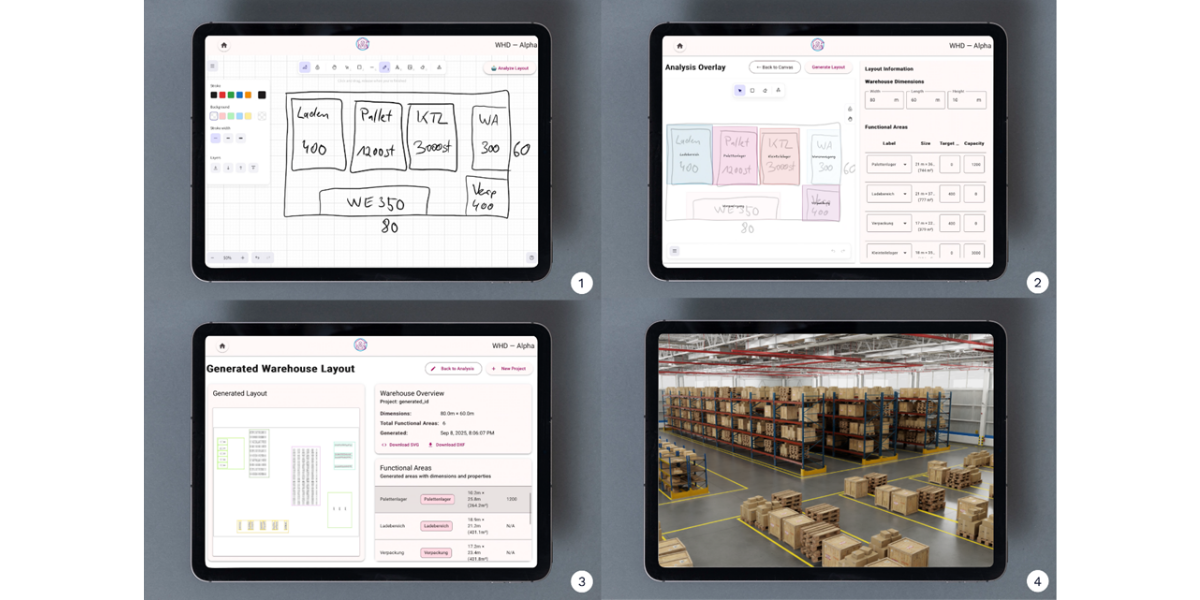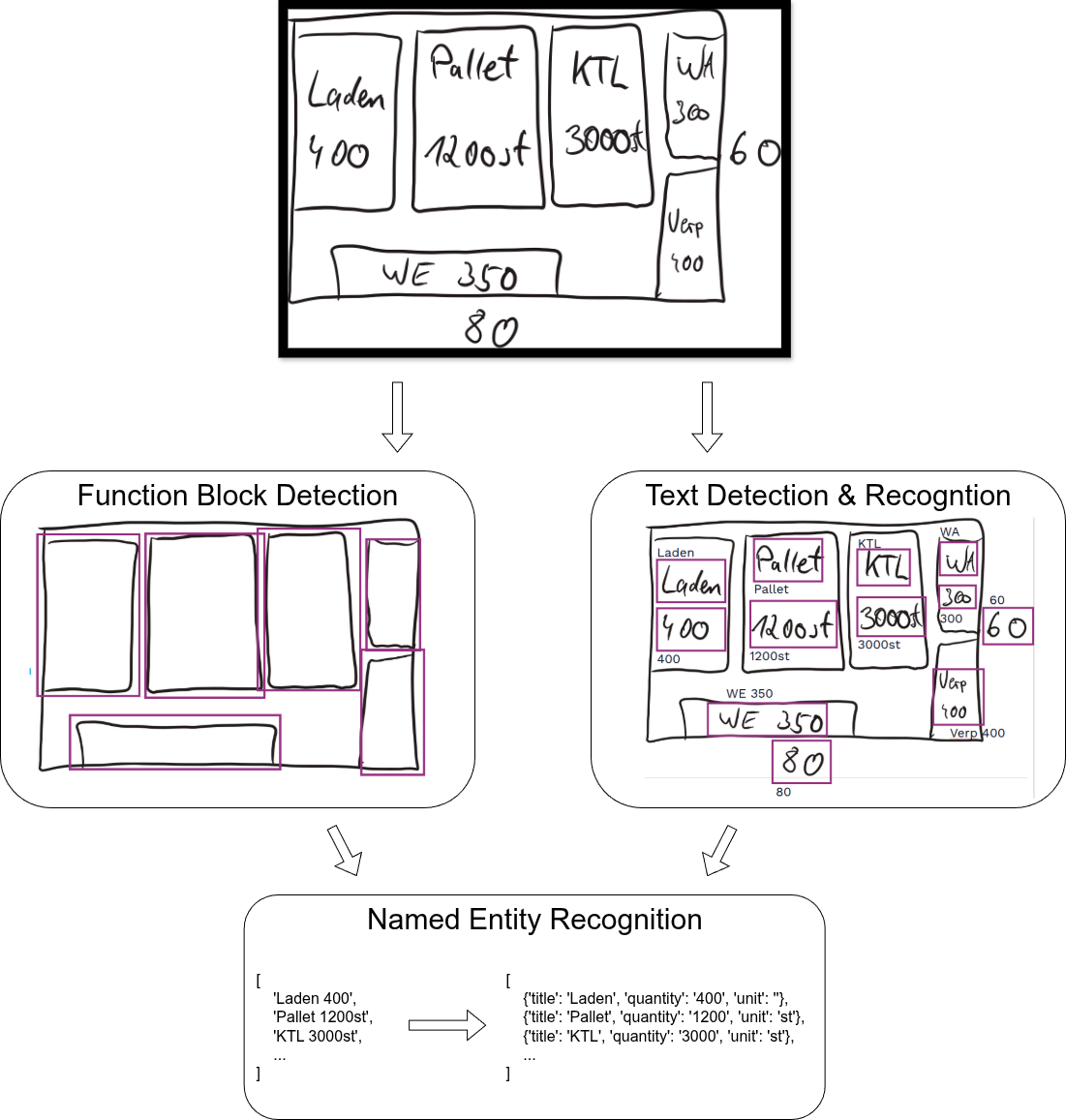
Several months of planning time, high costs, few comparable variants – the conceptual planning of modern warehouse systems is reaching its limits. While expert knowledge lies dormant in hand sketches and fragmented documents, pressure is growing: volatile supply chains, shorter delivery times, increasingly complex automation technologies. The WarehouseDesigner automates the first critical step in this process: it captures block layout sketches using AI-supported computer vision and generates optimized, compliant warehouse layouts in seconds – a decisive step towards more efficient warehouse planning.
The Challenge: Why Warehouse Planning is Reaching its Limits Today
Warehouse planning for modern warehouse systems follows a multi-stage process: After analyzing planning-relevant data and processes, concept planning follows, in which those solutions that best meet requirements and target functions such as costs or space requirements are selected from a large range of possible technology and layout variants. This is followed by detailed planning, tendering, implementation, and operation.
Depending on its complexity, the entire process takes several months to years and ties up considerable human and financial resources.
One of the core problems lies in the concept phase: it is a poorly structured decision-making problem with no clearly defined solutions. The process is heavily dependent on the expert knowledge of individual specialists.
As a result, often only a few variants from the entire solution space are considered—usually those based on the experience of the people involved.
Added to this is the fragmented data situation: relevant information is spread across spreadsheets, presentations, layout plans, documents, and emails. These media breaks increase the planning effort and prevent knowledge from previous projects from being systematically utilized.
At the same time, external pressure is increasing: global supply chains are becoming more volatile, customers expect shorter delivery times, and the diversity of modern automation technologies is making digital warehouse planning more challenging. Conventional methods are reaching their limits – they are complex, expensive, and can only compare a limited number of alternatives.
Project Vision: From Paper to Digital Planning
The WarehouseDesigner project addresses these challenges and takes a first step toward automating the concept phase of warehouse planning. In this phase, warehouse layouts are often first created on paper or as simple digital sketches, known as block layouts. The WarehouseDesigner captures these sketches using AI-based computer vision and automatically converts them into a structured digital form.

Figure 1 shows how it works at a glance:
1. Drawing or uploading: Block layouts are roughly drawn manually – either directly in the canvas or uploaded as photographed sketches. Functional areas (e.g., goods receipt, pallet storage) are named and optionally provided with capacities and the dimensions of the warehouse building.
2. Automatic recognition: The vision pipeline extracts all relevant information from the sketch and converts it into a structured data form. Planners can check the result and correct it if necessary.
3. Layout generation: A genetic algorithm places the functional areas within the warehouse dimensions in accordance with the rules, dimensions them based on the specifications, and fills them with suitable technologies. The system generates optimized variants that take into account target functions such as space efficiency or in the future short distances.
4. Visualization and export: The generated layouts are displayed in two dimensions and can be exported as CAD files. Three-dimensional visualization will also be available in the future. Planners can use the layouts as a basis for detailed planning or further customize them.
In addition to accelerating variant creation and layout in the concept planning phase, the WarehouseDesigner creates a structured database that can be used for recommender systems in the future. Further development will focus on supporting planning in existing warehouses and integrating material flow analyses into the placement of functional areas—an important contribution to the automation of warehouse planning and the utilization of existing expert knowledge.
Technical Core: The Vision Pipeline
The AI-based vision pipeline automatically recognizes functional areas and text in sketches and structures this information for further processing. This lays the foundation for precise, data-driven warehouse planning.
What is Extracted?
The pipeline captures three key types of information:
- Functional areas with rectangular boundaries
- Type and meta-information within the areas (e.g., goods receipt, pallet storage; capacity or target size)
- Total size of the warehouse based on the outer edges and its dimensions
This meta-information is crucial for the subsequent automatic dimensioning of the areas. Currently, either a capacity or a desired target area can be specified. The target area option is helpful because sketches do not have to be to scale. If numerical data is missing, the WarehouseDesigner system calculates the relative size in relation to the total area and the specified dimensions of the total warehouse.
Technical Implementation
Due to the complexity of layout generation and in order to meet the requirements of modern warehouse planning, the pipeline currently works with rectangle-based functional areas. This enables the efficient use of an object detection model to identify areas and creates the basis for automatically analyzing and optimizing layouts.
Figure 2 illustrates this multi-stage process from image to structured data structure:

1. Parallel recognition: An Object Detection Model identifies the functional areas, while another model recognizes text regions with handwritten or digital text.
2. Handwriting recognition: The recognized text regions are transferred to a vision-language model (VLM), which transcribes the handwriting.
3. Assignment: Recognized texts (titles and meta-information) are assigned to the corresponding functional areas based on their position. Text regions at the outer edges determine the storage dimensions.
4. Named entity recognition: The texts assigned to a functional area are aggregated and transferred to a language model. This extracts the relevant information – title, size, capacity, and their units – using Named Entity Recognition (NER).
The result is a digital representation of all functional areas with associated information, which forms the basis for automated workflows in warehouse planning and allows layouts to be developed and compared in a data-driven manner in the future.
Gradually, both the geometric shapes of the functional areas and their meta-information will become more complex in order to improve the planning process and further digitize warehouse planning step by step.
Layout Generation: From Sketch to Optimized Layout
Once the vision pipeline has recognized the drawn layout and planners have validated it in the front end, optimized layout variants can be generated from it. This step forms the core of data-driven warehouse planning, in which variants can be systematically compared and evaluated.
The Challenges
There are numerous constraints between a hand sketch and a usable layout:
- Areas must not overlap
- All areas must fit into the building
- Certain areas (goods receipt/issue) need to be in contact with the outer wall
- Connected areas should have short distances
- Target values (capacity, m²) should be achieved and maintained
- As little residual space as possible should remain
Achieving this balance manually requires many iterations and careful detail work in CAD software. A genetic algorithm can automatically calculate such iterations and identify a feasible, well-balanced solution from hundreds of designs in seconds, which means a significant gain in efficiency in the concept phase of warehouse planning.
Two-Stage Approach
1. Capacity dimensioning: The system calculates minimum dimensions that accommodate the required capacity with realistic parameters (aisle widths, rack aisles, service corridors). Existing target areas are respected as upper or lower limits. The goal is to maximize the use of the available space.
2. Spatial arrangement: Using these initial dimensions, the optimizer places all areas within the building envelope in accordance with regulations and taking into account quality criteria such as route relationships, compactness, and residual areas.
How it Works: Evolution within the Computer
The genetic algorithm allows many layout candidates to “compete” against each other in parallel and combines the best characteristics over several generations. Instead of gradually improving a single solution, the algorithm works with many different layout candidates simultaneously.
Each candidate describes in full where the functional areas are located, how large they are, what their orientation is, and whether there are any special anchors such as exterior wall contact. These are the “genes” of a layout variant, i.e., precisely those parameters that are crucial for structured warehouse planning.
1. Starting population: The system generates a diverse set of initial solutions. This diversity prevents all proposals from drifting in the same direction.
2. Evaluation (fitness): Each candidate is evaluated. Inadmissible conditions, such as intersecting areas or areas outside the building, receive very high penalty costs and have no chance of advancing to the next round. At the same time, soft targets are evaluated:
- How well do the areas fit their target sizes?
- How close are frequently interacting areas?
- How compact is the overall picture?
- How little residual space remains?
This evaluation makes it possible to identify practicable designs that are both functional and efficient, thus forming an important basis for reliable warehouse layouts.
3. Selection (tournament principle): Several candidates compete against each other, and the best ones prevail.
4. Combination (crossover): Successful partial ideas are mixed, such as a clever dock position from one layout with a particularly compact storage block arrangement from another.
5. Mutation: Small, targeted changes, such as minimal adjustments to positions or dimensions, keep the search flexible and prevent the system from getting stuck in local optima.
6. Exploration vs. exploitation: The best variants are carried over unchanged to the next generation. If diversity decreases, the WarehouseDesigner system deliberately generates new alternatives to expand the search space again.
After several dozen generations, a balanced, rule-compliant block layout emerges. A final local refinement smooths edges, aligns rectangles to the grid, and reduces small residual islands without violating hard rules.
The result is a layout that respects sketch specifications, takes path relationships into account, and makes efficient use of space. This creates a solid foundation on which further warehouse planning can be built precisely and time-efficiently—for example, for CAD exports, 3D visualizations, or detailed planning.
Outlook: Next Development Steps in AI-Supported Warehouse Planning
The WarehouseDesigner is continuously being developed – both in its practical application and in the underlying AI methods. The goal is to transform warehouse planning from a time-consuming, highly experience-based activity into a data-driven, interactive process.
Advanced Functions for Practical Use
In the next development phase, the WarehouseDesigner will be supplemented with interactive 3D visualization. This will allow layout variants to be presented clearly at an early stage, enabling planners to obtain specific customer feedback in the early concept phases.
In addition, the evaluation of layouts will also take material flow, conveyor technology, and performance limits into account in the future. This will allow bottlenecks and inefficient routes to be identified and avoided during the concept planning stage. Another development step is the creation of a curated portfolio of variants: instead of a single “best” solution, the WarehouseDesigner generates specific alternatives based on different target functions – such as minimum space, maximum scalability, short distances, or low investment costs. This makes conflicting goals in warehouse planning more transparent and enables more informed decisions to be made.
Research Perspectives: Potential for Future Developments
Based on the results achieved so far, several exciting research prospects are opening up that could expand the WarehouseDesigner in the long term. These topics mark possible next steps to further expand the performance and range of applications of AI-supported warehouse planning.
These include new approaches to robust geometry recognition, which in the future will also enable the precise capture of irregular warehouse structures, such as L-shapes or sloping surfaces, or existing buildings (brownfield planning). Reliable recognition and mapping of non-rectangular areas in the vision pipeline and their modeling and consideration in optimization would further increase the support options for users.
Similarly, the use of reinforcement learning offers interesting opportunities to improve the system through user feedback – for example, by learning which layouts are considered particularly efficient in practice. Not all quality criteria can be expressed in mathematical objective functions. Experienced planners often have a feel for which layouts are “good,” but this implicit knowledge is difficult to formalize. By learning iteratively from user evaluations, the parameters of the objective functions can be adjusted automatically. In this way, the WarehouseDesigner becomes better over time at generating layouts that are not only technically optimal, but also correspond to the specific preferences and experience of the users.
The use of knowledge from project data also holds great potential: experiential knowledge from previous plans, CAD drawings, or process models could be systematically incorporated into recommender systems. This would allow future plans to be based specifically on proven solutions – an important step toward learning, data-based warehouse planning.
The Way Forward
All developments pursue a common goal: to make warehouse planning more efficient, transparent, and accessible. The WarehouseDesigner is designed to relieve the burden on specialist planners, expand the range of solutions, and make decision-making processes more informed through data-based variant comparisons.
The WarehouseDesigner is currently under active development at Fraunhofer IML. Interested companies and research partners are invited to contact the authors of this article to help shape the next generation of warehouse planning.


